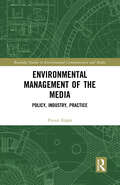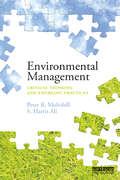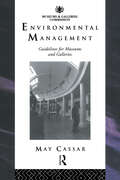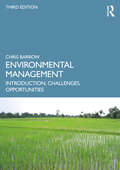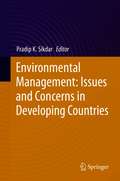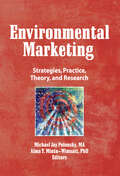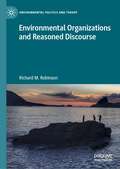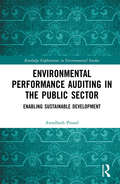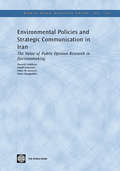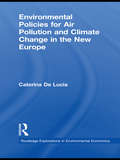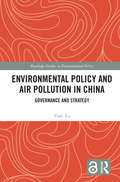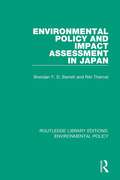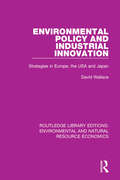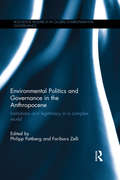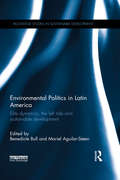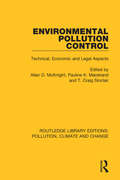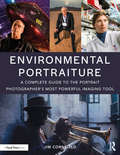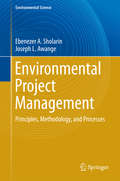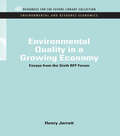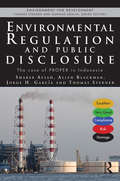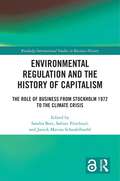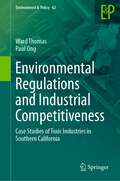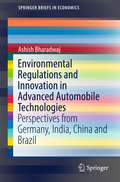- Table View
- List View
Environmental Management of the Media: Policy, Industry, Practice (Routledge Studies in Environmental Communication and Media)
by Pietari KääpäIn recent years the widely held misconception of the media as an ‘ephemeral’ industry has been challenged by research on the industry’s significant material footprint. Despite this material turn, no systematic study of this sector has been conducted in ways that considers the role of the media industries as consumers and users of a range of natural resources. Filling this gap, Environmental Management of the Media discusses the environmental management of the media industries in the UK and the Nordic countries. These Nordic countries, both as a set of small nations and as a regional constellation, are frequently perceived as some of the ‘greenest’ in the world, yet, not only is the footprint of the media industries practically ignored in academic research, but the very real stakes of the industries’ global impact are not comprehensively understood. Here, the author focuses on four key areas for investigating the material impact of Nordic media: (1) resources used for production and dissemination; (2) regulation of the media; (3) organizational management; and (4) labour practices. By adopting an interdisciplinary perspective that combines ecocritical analysis with interrogation of the political economy of the creative industries, Kääpä argues that taking the industries to task on their environmental footprint is a multilevel resource and organizational management issue that must be addressed more effectively in contemporary media studies. This book will be of great interest to students and scholars of media, communication and environmental studies.
Environmental Management: Critical thinking and emerging practices
by S. Harris Ali Peter R. MulvihillThe field of Environmental Management (EM) involves a broad and evolving repertoire of practices. The field originated around 1970 in response to new policy, regulation and public concern about environmental issues. EM has undergone many changes and improvements since then, progressing from a reactive, compliance-based focus toward, in leading cases, practices reflecting strong commitment to sustainability. And yet, EM remains, for the most part, ill-equipped to deal with the complex and highly uncertain implications of the ecological crisis. Environmental Management offers a rigorous critique of conventional EM and explores alternative ideas, frameworks and approaches that are currently considered "fringe", but which have the potential to transform the practice of EM. This book goes beyond narrow definitions and considers questions regarding the purpose, roles, scope and potential of environmental management. EM is situated and contextualized within the evolving and expanding realm of environment and sustainability literature. The book argues that new approaches to EM need to be more flexible, imaginative and better equipped to address future environmental problems of a scale and severity previously unforeseen. This book will be of great interest to students and scholars of environmental management, environmental planning, resource management, and environmental assessment.
Environmental Management: Guidelines for Museums and Galleries (Heritage: Care-Preservation-Management)
by May CassarThe key to the survival of museum collections is a stable indoor environment and vital to this is a well-maintained building with effective environmental services. Environmental Management sets out clearly the theory and practice of achieving an appropriate museum environment for both collections and people. The book emphasises the need for planning and places the environmental needs of museum collections at the forefront of the responsibilities of museum managers. May Cassar stresses the role of the building as the first line of defence against environmental instability, recognising the importance of regular environmental monitoring and control, and the division of museum spaces into critical areas housing collections and non-critical areas accommodating offices, cafes and communal spaces. Environmental Management presents a strategic approach to environmental management, in contrast to the piecemeal approach to environmental monitoring and control still practised by many museums. However, rather than providing ready solutions and rigid rules, the book introduces principles and ideas on which to base decisions about creating the appropriate environment.
Environmental Management: Introduction, Challenges, Opportunities (Routledge Perspectives On Development Ser.)
by Chris BarrowThis comprehensively updated third edition explores the nature and role of environmental management and offers an introduction to this rapidly expanding and changing field. It focuses on challenges and opportunities, and core concepts including sustainable development. The book is divided into five parts: Part I (Introduction to Environmental Management): four introductory chapters cover the justification for environmental management, its theory, scope, goals and scientific background Part II (Practice): explores environmental management in economics, law and business and environmental management’s relation with environmentalism, international agreements and monitoring Part III (Global Challenges and Opportunities): examines resources, challenges and opportunities, both natural and human-caused or human-aggravated Part IV (Responses to Global Challenges and Opportunities): explores mitigation, vulnerability, resilience, adaptation and how technology, social change and politics affect responses to challenges Part V (The Future): the final chapter considers the way ahead for environmental management in the future. With its well-structured coverage, effective illustrations and foundation for further, more-focused interest, this book is easily accessible to all.It is an essential reference for undergraduates and postgraduates studying environmental management and sustainability, and an important resource for many students on courses including environmental science, environmental studies and human geography.
Environmental Management: Issues and Concerns in Developing Countries
by Pradip K. SikdarThis book deals with issues and concerns for the human environment in the developing countries incorporating natural processes and systems, pollution removal technology, energy conservation, environmental impact assessment process, economics, culture, political structure and societal equity from a management point of view. Solutions to the emerging problems of the environment need a paradigmatic shift in approach from a process based model to a socio-political-economic model. Hence environmental management should involve equality and control over use of the finite natural resources and the balance between Earth’s biocapacity and humanity’s ecological footprint. Changes such as green technologies, human population stabilization and adoption of ecologically harmonious lifestyles are absolutely essential and will require redesigning of political institutions, policies and revisiting forgotten skills of sustainable practices of environmental management. These challenges should centre on environment governance using the concepts of common property, equity and security.This book is relevant for academics, professionals, administrators and policy makers who are concerned with various aspects of environment management and governance.
Environmental Marketing: Strategies, Practice, Theory, and Research
by William Winston Alma T Mintu-WimsattEnvironmental Marketing: Strategies, Practice, Theory, and Research is a timely resource for the 1990s. It examines a broad range of issues that affect environmental behavior while providing materials and guidance to marketing decisionmakers. It will guide your organization toward a decidedly “green” marketing movement, toward marketing concepts and tools that not only serve your organization's objectives but preserve and protect the environment as well.Environmental Marketing clearly defines the potential roles of organizations, consumers, and governments and examines how these groups impact environmental factors through the marketing process. The book helps you understand alternative perspectives to green marketing issues and, in turn, enables you to make clearer, more conscious decisions toward improving your environmental marketing performance.This resourceful text begins by defining the concept of environmental or “green” marketing and how the idea of a healthy planet and successful marketing strategies can co-exist. It discusses the consumer's behavior toward environmental products and how marketers can effectively educate them, the guidelines involved in doing so, and the consequences of failing to do so. The marketer's position on environmental changes in industry is examined along with alternatives for striking a balance between marketing objectives and environmental concerns. Finally, the book discusses the global response to environmental marketing and where multi-national organizations belong within this balance.Environmental Marketing is a book for all managers involved in decisions impacting the environment. It is also of great interest to public policymakers and academics who wish for quick insight into environmental marketing issues.
Environmental Markets
by Terry L. Anderson Gary D. LibecapEnvironmental Markets explains the prospects of using markets to improve environmental quality and resource conservation. No other book focuses on a property rights approach using environmental markets to solve environmental problems. This book compares standard approaches to these problems using governmental management, regulation, taxation, and subsidization with a market-based property rights approach. This approach is applied to land, water, wildlife, fisheries, and air and is compared to governmental solutions. The book concludes by discussing tougher environmental problems such as ocean fisheries and the global atmosphere, emphasizing that neither governmental nor market solutions are a panacea.
Environmental Organizations and Reasoned Discourse (Environmental Politics and Theory)
by Richard M. RobinsonThis book explores the meaning and role of “fair and reasoned discourse” in the context of our institutions for environmental decision processes. The book reviews the roles of our “environmental advocacy organizations”—such as The Sierra Club, The Audubon Society, the Environmental Defense Fund—in providing and ensuring that our discourse and decisions are fair and reasoned according to the criteria of being (i) inclusive of input from all affected, (ii) informed of relevant scientific and socio-economic information, (iii) uncorrupted by direct conflicts of interest, and (iv) logical according robust review by uncorrupted judges. These organizations are described and examined as expressions of “collective imperfect duty,” i.e. the coordinated duties with environmental direction. The current state of our discourse is examined in light of this fairness criteria, particularly in consideration of the cross-border problems that threaten tragedies of the global commons.
Environmental Performance Auditing in the Public Sector: Enabling Sustainable Development (Routledge Explorations in Environmental Studies)
by Awadhesh PrasadEnvironment and sustainable development challenges are a matter of global concern. Trillions of dollars of mostly public money are invested every year in domestic and international policies and programs to address these challenges. The effectiveness of these policies and programs is critical to environmental sustainability. Performance audits that examine the effectiveness of governmental policies and programs heavily influence their implementation. Despite this, performance auditing in the environment field has received very little academic attention. This book takes a closer look at performance auditing of public sector environmental policies and programs. It examines trends in global environmental performance auditing; and how it is currently practiced drawing on a global survey and case studies from Canada, India and Australia. In doing so, it identifies issues and challenges faced by Supreme Audit Institutions in undertaking these performance audits. This book will be of interest to students, scholars and practitioners of sustainable development, environmental auditing and public sector auditing as well as to donor organisations engaged in these areas.
Environmental Platform LEEDership at USGBC
by Aldo Sesia Michael W. Toffel Timothy S. SimcoeBy 2018, it was clear that U.S. Green Building Council (USGBC) had significantly contributed to the growth of green building, and over its 25-year history had become a powerful brand in the construction sector with its Leadership in Energy and Environmental Design (LEED) standard. Nonetheless, USGBC faced two significant challenges moving forward: maintaining LEED's leadership position as the green building standard in the U.S., and increasing the proportion of building stock that met the LEED standard. The case provides background on the USGBC and the evolution of its LEED standard, including how the standards are set, and green building benefits and costs.
Environmental Policies and Strategic Communication in Iran
by Fabio Santucci Daniele Calabrese Elena Stanghellini Khalil KalantariAir pollution in Tehran has become a major problem in recent years, due to the geographical position of the town, industries, and traffic. Most private and public vehicles are old and have no emission control systems. The Municipality of Tehran and the Department of Environment have started several actions to reduce pollution, with communication activities being part of their strategy. For better planning, and to make possible the monitoring and evaluation of the communication activities, a baseline study was completed in 2004 using direct interviews of 1,200 Tehran residents. The interviews covered aspects such as experiences, opions, knowledge, and willingness to act. Use of and trust in several information sources and media were also investigated, in order to select the best communication mix for future activities.
Environmental Policies for Air Pollution and Climate Change in the New Europe (Routledge Explorations In Environmental Economics Ser. #28)
by Caterina De LuciaThe interlinked issues of air pollution and energy policies in an enlarged Europe are currently subjects of major interest in economic, environmental, geography and regional sciences. This interest is understandable given the considerable consequences on human health and on climate change issues at not only a European, but a global level. In addition, the recent effects of economic fluctuation and oil prices as well as the actual restructuring of the European energy supply and security market raise a great deal of policy challenges. These issues have become an increasingly relevant concern, as the optimal design of policy by centralised European institutions has come under greater scrutiny. This book presents an integrated approach to recent regulations on air pollution with particular emphasis on transborder air pollution, climate change and energy policies in the new Europe. This integrated vision embraces the extent to which global pollution influences policy decisions at different institutional levels; the magnitude, by virtue of policy simulation analysis, of environmental policy tools (i.e. environmental taxes) on aggregate welfare and transboundary air emissions fluxes in light of the recent enlargement process; the European Trading System and its flexible mechanisms to curb carbon emissions and fulfil the European Union Kyoto Protocol’s commitments; and the developments of the new European energy strategy and its interdependencies across energy requirements, innovation, competitiveness and climate change. The book is primarily aimed at Postgraduates and Postdoctoral research students in economics, environmental economics, environmental sciences, or environmental policy disciplines. However, it should also be of interest to environmental economists, energy policy analysts, members of governmental and non-governmental agencies dealing with environmental policy, climate change or air pollution.
Environmental Policy and Air Pollution in China: Governance and Strategy (Routledge Studies in Environmental Policy)
by Yuan XuThis book systematically analyzes how and why China has expectedly lost and then surprisingly gained ground in the quest to solve the complicated environmental problem of air pollution over the past two decades. Yuan Xu shines a light on how China’s sulfur dioxide emissions rose quickly in tandem with rapid economic growth but then dropped to a level not seen for at least four decades. Despite this favorable mitigation outcome, Xu details how this stemmed from a litany of policy stumbles within the Chinese context of no democracy and a lack of sound rule of law. Throughout this book, the author examines China’s environmental governance and strategy and how they shape environmental policy. The chapters weave together a goal-centered governance model that China has adopted of centralized goal setting, decentralized goal attainment, decentralized policy making and implementation. Xu concludes that this model provides compelling evidence that China’s worst environmental years reside in the past. This book will be of great interest to students and scholars of Chinese environmental policy and governance, air pollution, climate change and sustainable development, as well as practitioners and policy makers working in these fields.
Environmental Policy and Impact Assessment in Japan (Routledge Library Editions: Environmental Policy #2)
by Riki Therivel Brendan F. BarrettFirst published in 1991. Japanese attitudes to pollution and environmental protection were distinctly equivocal. The Japanese are a nature-loving people, yet they are responsible for widespread environmental destruction; Japan has some of the world’s strictest environmental quality standards, but the country also has some of the world’s most environmentally damaged areas. In this book the authors present a broad and detailed analysis of policy and process in Japan in the late twentieth century. Brendan Barrett and Riki Therivel, who both have extensive research experience in Japan, describe interest group participation in Japan’s environmental policy-making and give an historical review of the relationship between economic growth and environmental problems. They look at the framework for environmental policy-making and outline the system for environmental management. This is complemented by a discussion of Environmental Impact Assessment, and by live case studies of the practical realities of EIA in Japan. With environmental problems reaching global proportions, countries all over the world have much to learn from the experience of Japan, and the book will be extremely useful to national government officials, to local planning officers responsible for EIA, and to environmental consultants working for commercial and industrial companies. It will also be essential reading for students of geography, environmental studies, Japanese studies and planning economics.
Environmental Policy and Industrial Innovation: Strategies in Europe, the USA and Japan (Routledge Library Editions: Environmental and Natural Resource Economics)
by David WallaceThis book, originally published in 1995, examines the evolution of environmental policy in 6 OECD countries. Through numerous examples, it contrasts the widely-varying political and regulatory styles and their consequences for innovation. Two industry-specific case studies provide a transnational perspective on the co-evolution of technology and environmental policy. The book concludes that innovation can be successfully harnessed by setting credible, long-term environmental goals and ensuring that regulatory instruments are grounded in flexibility, dialogue and trust.
Environmental Politics and Governance in the Anthropocene: Institutions and legitimacy in a complex world (Routledge Research in Global Environmental Governance)
by Fariborz Zelli Philipp PattbergThe term Anthropocene denotes a new geological epoch characterized by the unprecedented impact of human activities on the Earth’s ecosystems. While the natural sciences have advanced their understanding of the drivers and processes of global change considerably over the last two decades, the social sciences lag behind in addressing the fundamental challenge of governance and politics in the Anthropocene. This book attempts to close this crucial research gap, in particular with regards to the following three overarching research themes: (i) the meaning, sense-making and contestations emerging around the concept of the Anthropocene related to the social sciences; (ii) the role and relevance of institutions, both formal and informal as well as international and transnational, for governing in the Anthropocene; and (iii) the role and relevance of accountability and other democratic principles for governing in the Anthropocene. Drawing together a range of key thinkers in the field, this volume provides one of the first authoritative assessments of global environmental politics and governance in the Anthropocene, reflecting on how the planetary scale crisis changes the ways in which humans respond to the challenge. This volume will be of great interest to students and scholars of global environmental politics and governance, and sustainable development.
Environmental Politics in Latin America: Elite dynamics, the left tide and sustainable development (Routledge Studies in Sustainable Development)
by Benedicte Bull Mariel Cristina Aguilar-StoenSince colonial times the position of the social, political and economic elites in Latin America has been intimately connected to their control over natural resources. Consequently, struggles to protect the environment from over-exploitation and contamination have been related to marginalized groups’ struggles against local, national and transnational elites. The recent rise of progressive, left-leaning governments – often supported by groups struggling for environmental justice – has challenged the established elites and raised expectations about new regimes for natural resource management. Based on case-studies in eight Latin American countries (Argentina, Brazil, Chile, Ecuador, Colombia, Bolivia, El Salvador and Guatemala), this book investigates the extent to which there have been elite shifts, how new governments have related to old elites, and how that has impacted on environmental governance and the management of natural resources. It examines the rise of new cadres of technocrats and the old economic and political elites’ struggle to remain influential. The book also discusses the challenges faced in trying to overcome structural inequalities to ensure a more sustainable and equitable governance of natural resources. This timely book will be of great interest to researchers and masters students in development studies, environmental management and governance, geography, political science and Latin American area studies.
Environmental Pollution Control: Technical, Economic and Legal Aspects
by Allan D. McKnight Pauline K. Marstrand T. Craig SinclairOriginally published in 1974 this volume brings together contributions from lawyers, a nuclear physicist, a landscape architect, biologist, engineers and a former Inspector of the International Atomic Energy Agency. It covers technical and legal information on air, water, sea, land and noise pollution and provides a comprehensive guide, summary and introduction to the journal literature in separate but relevant disciplines. All of the contributors have specialised in studies in pollution control and contributed to the debate on use and management of the environment.
Environmental Portraiture: A Complete Guide to the Portrait Photographer’s Most Powerful Imaging Tool
by Jim CornfieldThis unique book is a photographer’s guide to the powerful medium of the environmental portrait. It explores in lucid detail the many "moving parts" of this imaging style, including the techniques and creative processes that drive some of this genre’s finest contemporary practitioners. In Environmental Portraiture, author Jim Cornfield puts his readers behind the viewfinder to help them successfully master what he calls "the portrait photographer’s most high-powered tool." In a series of detailed tutorial chapters and study models, Cornfield unpacks every practical aspect of the environmental portrait scenario, including research, location scouting, lighting interior and exterior environments, props and wardrobe, lens selection, composition, color, and after-capture. Along with this wealth of comprehensive nuts-and-bolts information, the book probes the deep structure of environmental portraiture—the blend of a sitter’s backstory with the meaningful visual clues in their surroundings. He introduces such concepts as "portraitcraft," "cognitive weight," and "the ideas and emotions quotient," among the many dimensions of an environmental portrait that create eye-opening revelations about the person in front of your lens. A separate section of the book is devoted to a prestigious roster of contemporary environmental portraitists, specifically recruited for this book to explore in-depth selected samples from their diverse portfolios. They bring with them a score of insights, tips and fascinating anecdotes that demonstrate their individualized approaches to this versatile branch of the photographer’s craft. Written for professionals, amateurs and serious students of photography, this book is both a guide and inspiration to creating powerful, communicative environmental portraiture.
Environmental Project Management
by Joseph L. Awange Ebenezer A. SholarinThis book offers a new framework that facilitates the development of more intelligent systems and methods for data analysis and international information sharing, such as the use of satellite imaging and geospatial data to predict changes in weather conditions and shifts in water levels, and to assess the extent of the forest cover remaining on Earth that is visible from space. It brings together the many aspects of science and technology, as well as formula and analytical approaches required for more informed decision-making. It also highlights the vital importance of understanding the technological, economic and social dimensions of environmental projects that have short-term results and long-term impacts. It is unique in that it clearly distinguishes between environmental project management (EnvPM) and green project management (GreenPM), and presents an amalgamation of environmental management and project management concepts, using geospatial methods to form an EnvPM concept. The book sets a benchmark for the professionalism with which environmental projects should be planned, executed, monitored, assessed and delivered. While primarily intended for professionals responsible for the management of environmental projects or interested in improving the overall efficiency of such projects, it is also a useful handbook for managers in the private, public and non-for-profit sectors. It is a valuable resource for students at both undergraduate and master's levels and an indispensable guide for anyone wanting to develop their skills in modern project management, environmental management and geospatial techniques. ``We are the first generation to feel the impact of climate change, and the last generation that can do something about it. '' US President Obama's address to the United Nations on Climate Change and Global warming (2015) hison: This book provides an in-depth, well-researched and science-based approach to applying key project-management and spatial tools and practices in environmental projects. An important read for leaders considering projects that balance social-economic growth against minimising its ill-effects on Planet Earth. - Todd Hutchison, Global Chairman of Peopleistic group.
Environmental Quality in a Growing Economy: Essays from the Sixth RFF Forum (RFF Environmental and Resource Economics Set)
by Henry JarrettTwelve scholars examine some leading problems in environmental quality, analyze present situations and future prospects, and suggest what might be done about them. Originally published in 1966
Environmental Regulation and Public Disclosure: The Case of PROPER in Indonesia (Environment for Development)
by Allen Blackman Thomas Sterner Shakeb Afsah Jorge H. GarciaThis book is a remarkable case study of an environmental policy initiative for a national environmental regulatory system in the information age. In 1995 the Indonesian Ministry of Environment took the bold step to launch an environmental disclosure initiative called the Program for Pollution Control, Evaluation and Rating (PROPER). Under PROPER, environmental performance of companies is mapped into a five-color grading scale – Gold for excellent, Green for very good, Blue for good, Red for non-compliance, and Black for causing environmental damage. These ratings are then publicly disclosed through a formal press conference and posted on the internet. Not only did this simple rating scheme create a major media buzz and enhanced environmental awareness of the general public, but it also unleashed a wide range of performance incentives that showed how markets with environmental information could function in a developing country setting. The authors provide a multidisciplinary analysis of how the PROPER program harnessed the power of public disclosure to abate the problem of industrial pollution. They describe how the program has successfully improved the average environmental compliance rate from close to thrity per cent in 1995 to as high as seventy per cent in 2011. This improvement was driven primarily by information disclosure, which avoided expensive and unpredictable legal enforcement through the court system of Indonesia. The combination of institutional history and detailed economic and analyses sheds light on the role of policy entrepreneurs who laid the foundation for disclosure and transparency, despite the constraints of the Suharto regime. The PROPER program is now internationally recognized and continues to serve as a model for many developing countries.
Environmental Regulation and the History of Capitalism: The Role of Business from Stockholm 1972 to the Climate Crisis (Routledge International Studies in Business History)
by Sandra Bott Janick Marina Schaufelbuehl Sabine PitteloudThis edited collection examines the historical role of business actors in climate and environmental governance since the 1970s. Through a compilation of recent, evidence-based historical research, this book unveils the origins of contemporary challenges in regulating environmental pollution. With original case studies, it offers a nuanced understanding of the environmental counter-offensive orchestrated by business leaders, associations, and think tanks post-1972, following the United Nations' pivotal Stockholm Conference on the Human Environment. Readers are presented with insights into the historical maneuvers of business entities aimed at mitigating regulatory risks, co-creating expertise, and framing the environmental debate. From revealing the tactics employed by various business actors to exploring the emergence of market-driven environmentalism, this volume offers a comprehensive exploration of the intricate dynamics shaping environmental policy. By contextualizing specificities and complexities, it enriches contemporary narratives on business influence and power dynamics within global capitalism. This book primarily caters to scholars across diverse historical disciplines, including business history, international relations, environmental history, and the history of capitalism. Additionally, it holds relevance for social scientists studying contemporary issues, policymakers grappling with environmental challenges, and those seeking a deeper understanding of the historical dimensions of climate governance.The Open Access version of this book, available at http://www.taylorfrancis.com, has been made available under a Creative Commons Attribution-Non Commercial-No Derivatives (CC BY-NC-ND) 4.0 license.
Environmental Regulations and Industrial Competitiveness: Case Studies of Toxic Industries in Southern California (Environment & Policy #62)
by Ward Thomas Paul OngWhile polluting industries in the U.S. continue to emit billions of pounds of toxic chemicals into the air, land and water every year, many economists and policy makers argue that environmental regulations stifle economic growth and reduce the standard of living for the American people. This book takes a fresh look at this question through three case studies of highly regulated polluting industries in the Southern California region: metal finishing, wood furniture, and dry cleaning. The case studies are based on a mix of qualitative and quantitative methods, including in-depth interviews with corporate managers and environmental regulators. The authors find that there is no universal pattern for predicting the effects of environmental regulations on industrial competitiveness, but that the outcomes depend on the structure of the industry being regulated, the design of the regulations, and the technologies that are available for compliance. The book is written in straight forward language that is accessible to the non-economist and will prove an essential resource for academics and students of all levels, and professionals and policy makers in the fields of environmental policy and regional economic development.
Environmental Regulations and Innovation in Advanced Automobile Technologies: Perspectives From Germany, India, China And Brazil (SpringerBriefs in Economics)
by Ashish BharadwajThe book examines innovation in environment-friendly technologies in the automobile industry. The focus of the book are Germany (a technology leader in the global automobile industry), on the one hand, and India, China and Brazil (technologically proficient emerging technology leaders) on the other hand. Patents have been used as a metric to measure and understand innovation. The book traces the evolution of regulatory standards in the automobile industry, relies on a unique patent dataset, and draws on a number of interviews conducted with regulators and engineers to get a better picture of how environmental policies and standards, including emission norms and fuel requirements, have developed overtime and now the industry has responded. The book’s core argument is that technological innovation is what has driven the industry in the past 125 years, but, at the same time, the industry has created problems and faced controversies with regard to its path dependency on carbon-intensive technologies. As a result, we have witnessed growing role of environmental regulators in ensuring that the growth path of the automobile industry, a powerhouse of growth of several economies, is aligned with the larger goals of addressing climate change and energy concerns. Against the backdrop of the emergence of Brazil, China and India in the global economy, the book focuses on the developments in these three countries, and draws parallels with Germany, which benefited from first mover advantage in technology and a substantial head-start in implementing cogent environmental policies. A standardized International Patent Classification (IPC) system has been used to, first, construct an index of regulatory stringency, based on regulations that came about between 1985 and 2010; and second, construct a unique cross-country weighted patent dataset for technologies invented in the past two and a half decades.
